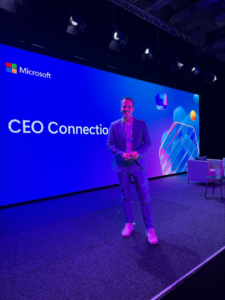Business innovation with IP 🎯 IP Management Pulse #24
Many IP experts in the IP community at I3PM, the HTB-EPO initiative, and other global IP offices and institutions in national and regional innovation systems have asked Prof. Alexander Wurzer: “Where can you be sure not to miss any important IP management content?” In fact, you have to follow a number of interesting feeds to really keep up with the global developments around IP management. To make this easier he decided to offer his own personal newsletter for IP management. Here, you can find the last issues in the archive and also subscribe. A fresh read with all important IP Management content will be sent to the subscribers every second Thursday at 7:00 (CET), so you can start your day informed.
The next Newsletter will cover the following topics:
62 years since Walmart opened its first store in Rogers, Arkansas. Back in 1962, 𝐟𝐞𝐰 𝐜𝐨𝐮𝐥𝐝 𝐡𝐚𝐯𝐞 𝐩𝐫𝐞𝐝𝐢𝐜𝐭𝐞𝐝 𝐭𝐡𝐚𝐭 𝐭𝐡𝐢𝐬 𝐬𝐦𝐚𝐥𝐥-𝐭𝐨𝐰𝐧 𝐝𝐢𝐬𝐜𝐨𝐮𝐧𝐭 𝐬𝐭𝐨𝐫𝐞 𝐰𝐨𝐮𝐥𝐝 𝐛𝐞𝐜𝐨𝐦𝐞 𝐭𝐡𝐞 𝐰𝐨𝐫𝐥𝐝’𝐬 𝐥𝐚𝐫𝐠𝐞𝐬𝐭 𝐫𝐞𝐭𝐚𝐢𝐥𝐞𝐫 📈.
𝐀𝐬 𝐈𝐏 𝐩𝐫𝐨𝐟𝐞𝐬𝐬𝐢𝐨𝐧𝐚𝐥𝐬, 𝐰𝐞 𝐦𝐮𝐬𝐭 𝐫𝐞𝐦𝐚𝐢𝐧 𝐯𝐢𝐠𝐢𝐥𝐚𝐧𝐭 𝐚𝐧𝐝 𝐟𝐨𝐫𝐰𝐚𝐫𝐝-𝐭𝐡𝐢𝐧𝐤𝐢𝐧𝐠. How can we help our organizations to anticipate and respond to potential disruptors? What role can intellectual property play in both fostering and protecting innovation?
The digital transformation of our world is not just a catchphrase – it’s a measurable reality reflected in patent statistics. 𝐆𝐥𝐨𝐛𝐚𝐥𝐥𝐲, 𝐬𝐨𝐟𝐭𝐰𝐚𝐫𝐞-𝐫𝐞𝐥𝐚𝐭𝐞𝐝 𝐩𝐚𝐭𝐞𝐧𝐭𝐬 𝐧𝐨𝐰 𝐝𝐨𝐦𝐢𝐧𝐚𝐭𝐞 𝐭𝐡𝐞 𝐢𝐧𝐧𝐨𝐯𝐚𝐭𝐢𝐨𝐧 𝐥𝐚𝐧𝐝𝐬𝐜𝐚𝐩𝐞. 𝐓𝐡𝐞 𝐢𝐦𝐩𝐥𝐢𝐜𝐚𝐭𝐢𝐨𝐧𝐬 𝐚𝐫𝐞 𝐜𝐥𝐞𝐚𝐫: 𝐬𝐨𝐟𝐭𝐰𝐚𝐫𝐞 𝐢𝐬 𝐧𝐨𝐰 𝐭𝐡𝐞 𝐝𝐨𝐦𝐢𝐧𝐚𝐧𝐭 𝐟𝐨𝐫𝐜𝐞 𝐧𝐨𝐭 𝐣𝐮𝐬𝐭 𝐢𝐧 𝐢𝐧𝐯𝐞𝐧𝐭𝐢𝐨𝐧𝐬, 𝐛𝐮𝐭 𝐢𝐧 𝐭𝐡𝐞 𝐛𝐫𝐨𝐚𝐝𝐞𝐫 𝐞𝐜𝐨𝐧𝐨𝐦𝐲.
Microsoft’s big AI event (Open AI, ChatGPT, Copilot…) took place in Berlin with the keynote speech by the celebrated company leader Satya Nadella. I can tell you that this will be a game changer, what is already possible today and is coming to us very soon. It will change the way we “do” with computers and how we work with them 𝐚𝐧𝐝 𝐡𝐨𝐰 𝐰𝐞 𝐜𝐚𝐧 𝐭𝐞𝐥𝐥 𝐬𝐭𝐨𝐫𝐢𝐞𝐬.
The landscape of innovation is undergoing a seismic shift, driven by the 𝐬𝐲𝐬𝐭𝐞𝐦𝐚𝐭𝐢𝐜 𝐢𝐧𝐭𝐞𝐠𝐫𝐚𝐭𝐢𝐨𝐧 𝐨𝐟 𝐀𝐫𝐭𝐢𝐟𝐢𝐜𝐢𝐚𝐥 𝐈𝐧𝐭𝐞𝐥𝐥𝐢𝐠𝐞𝐧𝐜𝐞 (𝐀𝐈) 𝐢𝐧𝐭𝐨 𝐞𝐯𝐞𝐫𝐲 𝐬𝐭𝐚𝐠𝐞 𝐨𝐟 𝐭𝐡𝐞 𝐢𝐧𝐯𝐞𝐧𝐭𝐢𝐨𝐧 𝐩𝐫𝐨𝐜𝐞𝐬𝐬. This transformation accelerates not only the pace of innovation but also enhances the quality and scope of ideas generated.
By leveraging AI, teams can focus on creative problem-solving rather than getting bogged down in repetitive tasks.
In today’s digital-first world, a company’s user experience (UX) and user interface (UI) have become the face of its brand. These digital touchpoints are often the primary way customers interact with businesses, making it crucial to protect them with intellectual property. Research shows that a positive user experience can increase customer retention by up to 16% and boost revenue by 5-35%.
New 🔗dIPlex entry: Patents for Medical Technologies
The world of medicine is constantly evolving, with new technologies emerging to improve healthcare delivery and patient outcomes. Patents play a vital role in this landscape, incentivizing innovation and protecting the investments made in developing these groundbreaking medical technologies.
New 🔗dIPlex entry: Combining human and artificial intelligence for patent searches
The integration of artificial intelligence (AI) with human expertise is transforming patent searches, offering a hybrid approach that combines the strengths of both. AI technologies are revolutionizing tasks like prior art searches, claim drafting, and data analysis, significantly reducing time and improving accuracy.
Whom to follow
Olivier Corticchiato provides you on LinkedIn with an overview of the IP and innovation landscape based on his extensive expertise from his in-house background. He does this with an international perspective and offers in addition to the European position a comparison with the Chinese situation. Finally, he provides additional insights into the biotechnology, pharmaceutical and life science sectors. He also raises awareness of intellectual property by supporting the IP Business Academy as an ambassador.
In his LinkedIn feed, Magnus Hakvåg provides an overview of international standardisation trends to support innovation. He focuses on the use of “serious games”, which he also applies in the IP field to educate IP experts. Finally, he reports on a number of interesting IP events worldwide. He also supports the IP Business Academy as an ambassador.
Emerging issues for SMEs and IP audits
In today’s connected world, the normal standard commercial practices of obtaining warranties and indemnities may not apply. Robert Pocknell highlights some of the complexities of SEP licensing and the commercial risks faced by many SMEs.
Managing University Patent Portfolios: A Smarter Approach to Inventions
In a world where universities generate countless new inventions, the challenge isn’t just creating innovative ideas — it’s deciding which ones to invest in. With limited resources — a natural reality — universities must be strategic in managing their patent portfolios, ensuring they optimize their choices to bring the most promising inventions to market.
Mobile communication ecosystems
Today, more and more communication is taking place via mobile devices, and this no longer only applies to phone calls, but also to communication with machines and the provision of services. This is leading to the creation of new digital business ecosystems as part of the IoT, but also for a range of mobile applications. This formation of ecosystems changes the rules of competition and raises a number of new IP-related questions. This blog post presents a research project on “The role of patents in digital business ecosystems”.
Principles of disruptive technologies
For a disruptive innovation, the new entrant must start with a market entry either at a niche market or at the lower end of an existing market. So, not every new business causing trouble to the incumbents is a disruptive business. Often companies also fail, when a new company directly attacks the main market, e.g. with an incremental innovation of a commodity. This is nevertheless no disruption.













